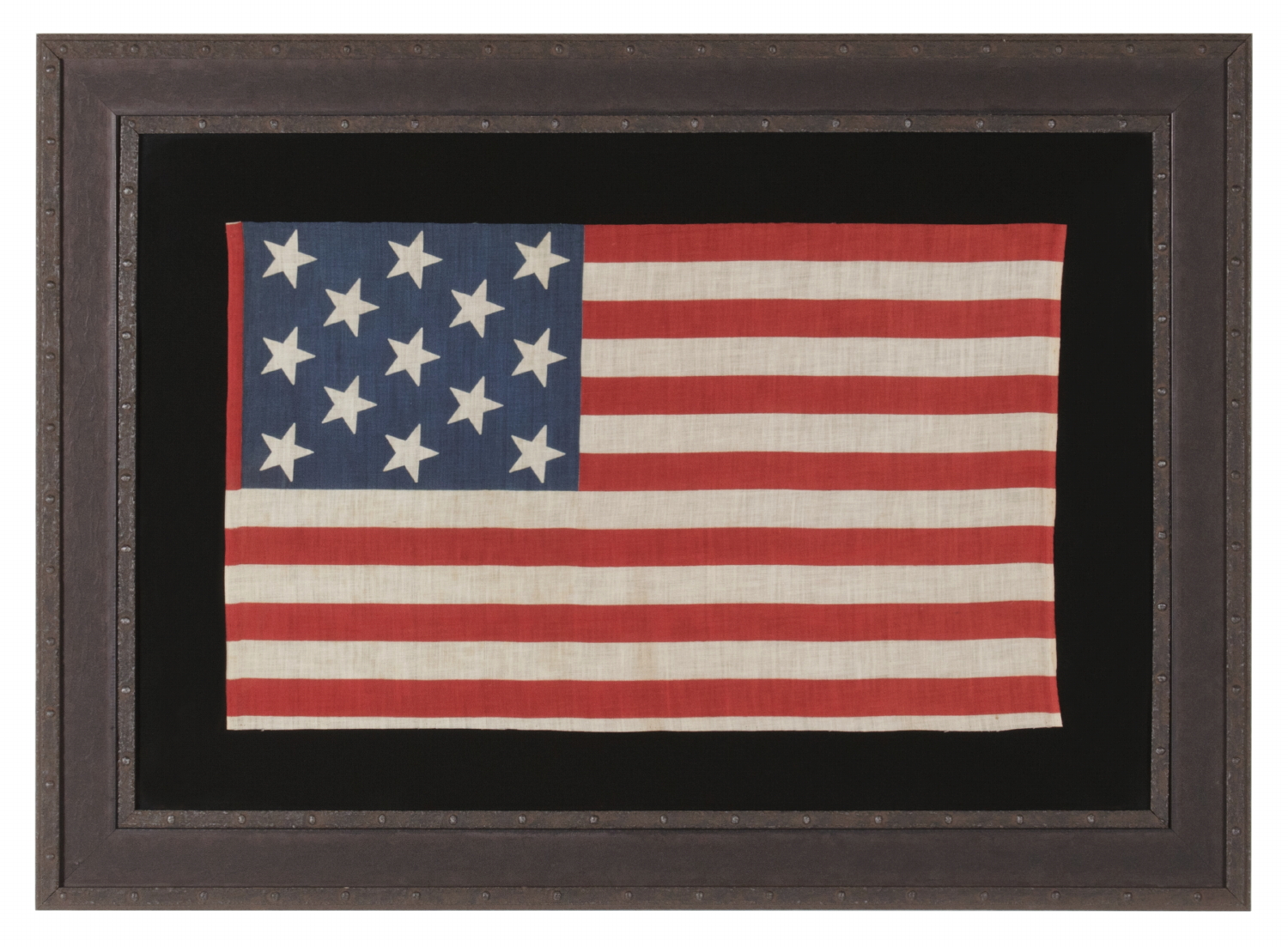
| |
13 STAR PARADE FLAG IN A 3-2-3-2-3 PATTERN, MADE CA 1876-1898, UNUSUALLY LARGE AND WITH AN UNUSUAL STAR PATTERN AMONG ITS COUNTERPARTS OF THE 19TH CENTURY |
|
| Available: |
Sold |
| Frame Size (H x L): |
25.25" x 35" |
| Flag Size (H x L): |
14.75" x 24" |
|
| Description....: |
|
13 star American national parade flag, printed on cotton, made sometime in the period between 1876 and 1898. This is a very rare size for the 13 star count in a printed flag. Most are very small (less than 10”). Before purchasing a small group of about eight of these flags some years ago, I had never before seen an example that bore any resemblance. The group was found in Canada, and were almost certainly made there for the American market, or made in the States for the Canadian market for an event where there was U.S. involvement. Whatever the case may be, others in the same style have since been found there and Canadian manufacture would explain the scarcity.
The stars are quite large in scale. Each is canted at a slight angle such that one point is directed in the 1:00 position. These are arranged in staggered lineal rows in counts of 3-2-3-2-3, which is the most common configuration found in 19th century flags with 13 stars that have pieced-and-sewn construction, but is highly unusual among printed parade flags.
In most cases the 3-2-3-2-3 design can also be viewed as a diamond of stars, with a star in each corner and a star in the very center. It can also be interpreted as a combination of the crosses of St. Andrew and St. George, which some experts feel could have been the design of the very first American flag, serving as a link between this star pattern and the British Union Jack. The pattern is often attributed--erroneously in my opinion--to New Jersey Senator Francis Hopkinson, a member of the Second Continental Congress and signer of the Declaration of Independence, who is credited with having played the most significant role in the original design of the American national flag. Hopkinson's original drawings for the design of the flag have not survived and his other depictions of 13 star arrangements for other devices are inconsistent.
On this particular example, note the unusual coloration of the hoist area, adjacent to the canton, which is red instead of the typical white. This adds a distinctly unusual feature to the flag's visual presentation and is a nice compliment to the field of large, canted stars. The presence of an extra amount of white beneath the 13th stripe is also atypical. This represents blank space between one flag and the next. Parade flags were printed on a bolt of fabric, like other printed textiles, and were clipped from the bolt as desired when sold. Many parade flags don't have any significant amount of space between one flag and the next, so it is unusual to see this much open white space; and there was, in fact, even more beyond the point where this one was trimmed, as evidenced by other surviving examples of flags in this style, some of which appear to have a full 14th white stripe.
13 star flags have been flown throughout our nation’s history for a variety of purposes. They were hoisted at patriotic events, including Lafayette’s visit in 1825-26, the celebration of the nation's centennial in 1876, and the sesquicentennial in 1926. They were displayed during the Civil War, to reference past struggles for American liberty and victory over oppression, and were used by 19th century politicians in political campaigning for the same reason. The U.S. Navy used the 13 star count on small boats until 1916, because it was easier to discern fewer stars at a distance on a small flag. Commercial flag-makers mirrored this practice and some private ships flew 13 star flags during the same period as the Navy. The use of yachting ensigns with a wreath of 13 stars surrounding an fouled anchor, which allowed pleasure boats to bypass customs between 1848 and 1980, persists today without an official purpose.
Mounting: The flag has been stitched to 100% cotton, black in color, which has been washed to reduce excess dye. An acid-free agent was added to the wash to further set the dye and the fabric was heat-treated for the same purpose. The mount was then placed in a modern molding that is constructed of wood, but has a finish that presents like antique iron. Spacers keep the textile away from the glazing, which is U.V. protective glass.
Condition: There is some foxing throughout. Many of my clients prefer early flags to show their age and history of use. |
|
|
|
| Collector Level: |
Intermediate-Level Collectors and Special Gifts |
|
| Flag Type: |
Parade flag |
|
| Star Count: |
13 |
|
| Earliest Date of Origin: |
1876 |
|
| Latest Date of Origin: |
1898 |
|
| State/Affiliation: |
13 Original Colonies |
|
| War Association: |
|
|
| Price: |
SOLD |
|
| |
Views: 1571 |
|
|
|

